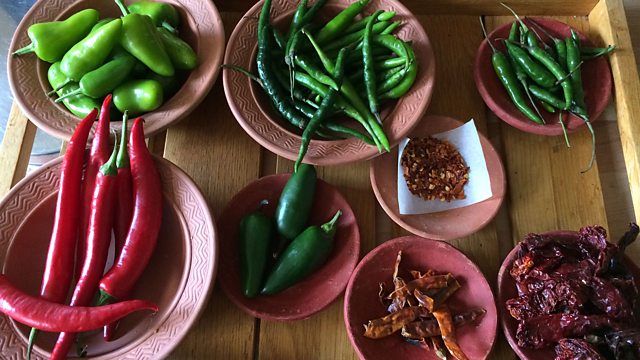How Chillies Became Hot
The origins and history of chillies and why we eat a food that burns.
The chilli pepper is a work of ‘evolutionary elegance’. Its complex chemistry can fool our brains. Why do we eat something that causes us pain?
Mike Williams explores the origins and history of chillies, thought to be the hot and humid climates of Bolivia and northern Brazil before being spread through the world by Portuguese colonists in the 15th entury. He finds out that ancient chillies were not hot.
Dr Josh Tewkesbury from the University of Washington explains why the chilli pepper developed heat and why human beings are one of the only mammals in the world to actually enjoy eating them. We unlock the pungency and flavour of chillies in curries with chef and writer Roopa Gulatti. And we uncover their power and punch in powder and pepper spray with Dr Anuj Baruah, a biotechnologist in the north-eastern state of Assam, India, who extracted the chemical compound inside the chilli for India’s ministry of defence.
Award winning science writer and journalist, Deborah Blum gives her analysis of the chemistry inside the chilli and its development to explain why she thinks that plants like chillies are ‘formidable military machines’. Finally, Mike tastes one of the world’s hottest - the bhut jolokia - also known as the ghost or poison pepper.
Produced by Nina Robinson
(Photo: A selection of chillies)
Last on
More episodes
Previous
Broadcasts
- Fri 19 Jun 2015 18:32GMT���˿��� World Service Online
- Fri 19 Jun 2015 23:32GMT���˿��� World Service Online
- Sun 21 Jun 2015 21:32GMT���˿��� World Service Online
- Mon 22 Jun 2015 04:32GMT���˿��� World Service Online
- Mon 22 Jun 2015 12:32GMT���˿��� World Service Online
Get the podcast
Subscribe or download individual episodes for free
Why do we look the way we do?
Tattoos, trainers, jeans, hair, ties ... why?
Podcast
-
![]()
The Why Factor
The extraordinary and hidden histories behind everyday objects and actions


